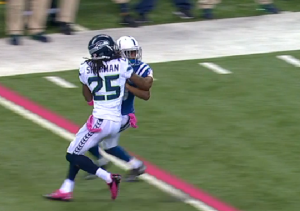Will Officials Really Increase Defensive Holding Calls During the Regular Season? 6
After watching Richard Sherman and other “top” defensive backs manhandle receivers during the 2013 season while rarely being penalized, the NFL has made a point of emphasis for 2014 to crack down on defenders using their hands to keep receivers from getting into their routes.
So far in the preseason officials have been throwing flags like confetti during a parade, but it is not yet clear whether NFL Week 1 odds should be adjusted to account for the change.
There is no question that in recent years some of the top defensive players in the league have been able to skirt the rules originally created in the late 1970s to keep defensive backs like Hall of Famer Mel Blount from completely dominating the game.
The 1978 rules to limit the ability of defenders to put hands on receivers were the first of a multitude of rules that have been created over the last 36 years that have helped increase offense within the game.
The impact in 1978 was immediate.
In 1977, only one quarterback, Joe Ferguson of the Buffalo Bills at 200.2 yards per game, averaged 200 yards passing per game and only Bob Griese (22) and Ken Stabler (20) had 20 or more touchdown passes.
The 1978 season did also see the addition of two more games, but regardless, the increase in passing offense was quite obvious. Fran Tarkenton led the league averaging 216 passing yards per game and six quarterbacks averaged 200 or more yards per game. In addition, Terry Bradshaw tossed 28 touchdown passes and four others eclipsed 20 touchdown passes.
Of course, that was just the start of the offensive explosion in the NFL. In 1979 Dan Fouts passed for 4,082 yards (255 per game) and 10 eclipsed 200 yards passing per contest.
In 1981 Fouts became the first quarterback in NFL history to average 300 yards per game and half of the teams in the NFL (14 of 28) had a starting quarterback who averaged more than 200 yards per game. Fouts and Steve Bartkowski of the Atlanta Falcons passed for at least 30 touchdowns and 11 quarterbacks had 20 or more touchdown passes.
Those numbers seem a bit pedestrian compared to the current game when 26 of 32 teams had a starting quarterback passing for more than 200 yards per game in 2013, but were important in the evolution of the game.
Surprisingly, even with such prolific offense, some defenses have still been able to have an impact. That was certainly the case in 2013 when the Seattle Seahawks allowed opponents only 14.4 points per contest.
They were especially dominant in the playoffs when they held both the New Orleans Saints and San Francisco 49ers nearly 10 points below their season averages to reach the Super Bowl. Read the rest of this entry →




